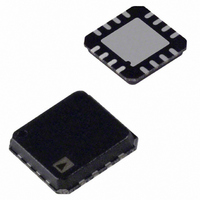AD8270ACPZ-RL Analog Devices Inc, AD8270ACPZ-RL Datasheet - Page 17

AD8270ACPZ-RL
Manufacturer Part Number
AD8270ACPZ-RL
Description
10MHz, Low Dist Dual Channel Diff Amp
Manufacturer
Analog Devices Inc
Datasheet
1.AD8270ACPZ-WP.pdf
(20 pages)
Specifications of AD8270ACPZ-RL
Amplifier Type
Differential
Number Of Circuits
2
Output Type
Rail-to-Rail
Slew Rate
30 V/µs
Gain Bandwidth Product
20MHz
Current - Input Bias
500pA
Voltage - Input Offset
450µV
Current - Supply
2.3mA
Current - Output / Channel
100mA
Voltage - Supply, Single/dual (±)
5 V ~ 36 V, ±2.5 V ~ 18 V
Operating Temperature
-40°C ~ 85°C
Mounting Type
Surface Mount
Package / Case
16-LFCSP
Lead Free Status / RoHS Status
Lead free / RoHS Compliant
-3db Bandwidth
-
Lead Free Status / RoHS Status
Lead free / RoHS Compliant
The AD8270 Specifications section and Typical Performance
Characteristics section show the performance of the part primarily
when it is in the difference amplifier configuration. To get a good
estimate of the performance of the part in a single-ended
configuration, refer to the difference amplifier configuration
with the corresponding closed-loop gain (see Table 9).
Table 9. Closed-Loop Gain of the Difference Amplifiers
Difference Amplifier Gain
0.5
1
2
Gain of 1 Configuration
The AD8270 is designed to be stable for loop gains of 1.5 and
greater. Because a typical voltage follower configuration has
a loop gain of 1, it may be unstable. Several stable G = 1 configu-
rations are listed in Table 8.
DIFFERENTIAL OUTPUT
The AD8270 can easily be configured for differential output.
Figure 48 shows the configuration for a G = 1 differential output
amplifier. The OCM node in the figure sets the common-mode
output voltage. Figure 49 shows the configuration for a G = 1
differential output amplifier, where the average of two voltages
sets the common-mode output voltage. For example, this
configuration can be used to set the common mode at 2.5 V,
using just a 5 V reference and GND.
Closed-Loop Gain
1.5
2
3
Rev. 0 | Page 17 of 20
–IN
+IN
–IN
+IN
Note that these two configurations are based on the G = 0.5
difference amplifier configurations shown in Figure 42 and
Figure 45. A similar technique can be used to create differential
output with a gain of 2 or 4, using the G = 1 and G = 2 difference
amplifier configurations, respectively.
A
Figure 48. Differential Output, G = 1, Common-Mode Output Voltage
Figure 49. Differential Output, G = 1, Common-Mode Output Voltage
1
2
3
4
1
2
3
4
10kΩ
10kΩ
10kΩ
10kΩ
10kΩ
10kΩ
10kΩ
10kΩ
20kΩ
20kΩ
+OUT
_
+
+OUT
_
+
10kΩ
10kΩ
20kΩ
20kΩ
AD8270
AD8270
OCM
B
Set as the Average of Two Voltages
–OUT
–OUT
20kΩ
20kΩ
10kΩ
10kΩ
Set with Reference Voltage
+
+
_
_
20kΩ
20kΩ
10kΩ
10kΩ
10kΩ
10kΩ
10kΩ
10kΩ
10kΩ
10kΩ
12
10
12
10
11
11
9
9
+IN
–IN
+IN
–IN
A
=
=
+IN
–IN
+IN
–IN
V
V
V
V
+IN
OCM
+IN
+OUT
V
A
OCM
– V
– V
= V
+ V
2
+ V
–IN
–IN
+OUT
B
–OUT
= V
V
= V
V
OCM
OCM
+OUT
+OUT
+ V
AD8270
=
V
–OUT
A
– V
– V
+ V
2
–OUT
–OUT
B
+OUT
–OUT
+OUT
–OUT













